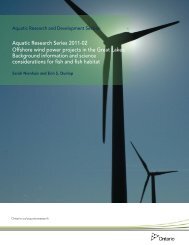Ontario's Natural Heritage Areas - Ministry of Natural Resources
Ontario's Natural Heritage Areas - Ministry of Natural Resources
Ontario's Natural Heritage Areas - Ministry of Natural Resources
You also want an ePaper? Increase the reach of your titles
YUMPU automatically turns print PDFs into web optimized ePapers that Google loves.
5.5 Migratory Bird Sanctuaries<br />
Introduction<br />
In 1916, Great Britain (on behalf <strong>of</strong> Canada) and<br />
the United States signed the Migratory Birds<br />
Convention, a treaty that obliges both countries<br />
to preserve migratory birds and protect them<br />
from indiscriminate slaughter. And the Migratory<br />
Birds Convention Act (1994) enables Environment<br />
Canada to meet Canada’s obligations outlined in<br />
the Convention. Migratory Bird Sanctuaries protect<br />
migratory birds against physical disturbance and<br />
hunting, a primary threat in the early part <strong>of</strong> the 20th<br />
Century. While the Act does address protection <strong>of</strong><br />
active nests, it does not address protection <strong>of</strong> other<br />
habitats that are also important to migrating birds.<br />
Ninety-two Migratory Bird Sanctuaries, covering<br />
approximately 11.2 million ha, are located in Canada.<br />
Nine sanctuaries have been established in Ontario<br />
(Table 5-3, Fig. 5-4) (CWS and CWF, 2007).<br />
Legislation and Policy Basis<br />
The Migratory Birds Convention Act provides for<br />
the establishment <strong>of</strong> Migratory Bird Sanctuaries.<br />
Although the Canadian Wildlife Service administers<br />
these areas, the Government <strong>of</strong> Canada does not<br />
always own them. Sanctuaries can be designated by<br />
Order-in-Council on private lands with the consent<br />
<strong>of</strong> the landowner. A private land sanctuary can<br />
be deregulated should the landowner withdraw<br />
consent or the area loses its value to migratory birds<br />
(Environment Canada, 1991:7-12).<br />
Image by P.A. Gray<br />
Ontario’s <strong>Natural</strong> <strong>Heritage</strong> <strong>Areas</strong> 132<br />
Table 5-3. Migratory Bird Sanctuaries and associated<br />
designations in Ontario.<br />
Migratory Bird Sanctuary Area (ha)<br />
Beckett Creek, 1969 103.0<br />
Chantry Island (IBA), 1957 81.0<br />
Eleanor Island (NWA), 1971 0.6<br />
Hannah Bay (RS, IBA), 1939 29,500.0<br />
Mississippi Lake (NWA), 1959 430.0<br />
Moose River (RS, IBA), 1958 1,457.0<br />
Rideau, 1957 809.4<br />
St. Joseph’s Island, 1951 940.0<br />
Upper Canada, 1961 2,663.0<br />
Total 35,984.0<br />
RS = also a Ramsar Convention Site.<br />
NWA = contains or overlaps with a National Wildlife Area.<br />
IBA = contains or overlaps with an Important Bird Area.<br />
Protection Goal and/or Objectives<br />
A principal goal/objective <strong>of</strong> Migratory Bird<br />
Sanctuaries is to protect migratory shorebird,<br />
waterfowl, and seabird populations on their staging<br />
and breeding grounds. Secondary objectives include<br />
research, habitat improvement, and ecotourism (CWS<br />
and CWF, 2003).

















